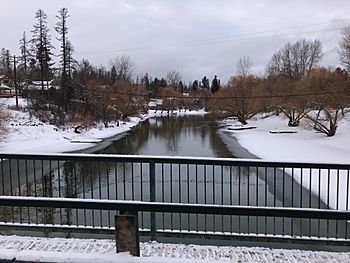Whitefish River (Montana) facts for kids
Quick facts for kids Whitefish River |
|
|---|---|

Whitefish River looking west from Baker Avenue Bridge in Whitefish
|
|
| Native name | epɫx̣ʷy̓u |
| Country | Flathead County, Montana |
| Physical characteristics | |
| Main source | Outlet of Whitefish Lake 2,999 feet (914 m) 48°24′55″N 114°21′12″W / 48.41528°N 114.35333°W |
| River mouth | Confluence with Stillwater River just before the Flathead River 2,910 feet (890 m) 48°12′44″N 114°17′13″W / 48.21222°N 114.28694°W |
| Length | 24.8-mile-long (39.9 km) |
| Basin features | |
| River system | Columbia River |
| Tributaries |
|
The Whitefish River is a river in Montana, USA. It flows south for about 24.8 miles (39.9 km). The river starts at Whitefish Lake. It then joins the Stillwater River. This happens just before the Stillwater River reaches the Flathead River.
The Whitefish River is part of a much larger river system. This system is called the Columbia River basin. The Flathead River flows into the Clark Fork. The Clark Fork then flows into the Pend Oreille River. Finally, the Pend Oreille River joins the huge Columbia River.
Contents
History of the Whitefish River
The Whitefish River and Whitefish Lake got their names in the 1850s. They were named because many whitefish lived there. People used to catch a lot of these fish.
The Salish people have their own name for the river. They call it epɫx̣ʷy̓u. This name means "has whitefish."
Where the Whitefish River Flows
The Whitefish River begins at Whitefish Lake. It flows mostly south. It joins the Stillwater River near Kalispell. This meeting point is about 1 mile (1.6 km) east of Kalispell.
The very first part of the river flows through the city of Whitefish. This section is about 2.5 miles (4.0 km) long.
The Whitefish River has three important smaller streams that flow into it. These are called tributaries.
- Cow Creek flows southwest for about 4.5 miles (7.2 km). It joins the river about 2 miles (3.2 km) from Whitefish Lake.
- Haskill Creek starts high up in the Whitefish Mountain Resort. It flows south for 11 miles (18 km). Haskill Creek meets the Whitefish River about 4.5 miles (7.2 km) from Whitefish Lake.
- Walker Creek begins in the southern part of the Whitefish Range. It joins the Whitefish River about 5 miles (8.0 km) downstream from Whitefish Lake.
River Health and Fish Species
In 2014, experts checked the Whitefish River's health. The Montana Department of Environmental Quality (DEQ) found a problem. The river's water was too warm. This high temperature can harm the animals living in the water. They suggested lowering the water temperature by about 0.99 °F.
Fish Species in the Whitefish River
Some fish are like natural health indicators for a river. If they are doing well, the river is likely healthy. Two important indicator fish in the Whitefish River are the Bull trout (Salvelinus confluentus) and the westslope cutthroat trout (Oncorhynchus clarki lewisi). However, their numbers have become much smaller.
A big problem for the native cutthroat trout is mixing with other fish. Non-native rainbow trout (Oncorhynchus mykiss) can breed with them. This creates hybrid fish. A study in 2001 showed that most of the trout in the river were rainbow trout. Only a small part had westslope cutthroat trout genes.
Other native fish species found in the river include:
- The mountain whitefish (Prosopium williamsoni), which the river is named after.
- Largescale sucker ((Catostomus macrocheilus)).
- Longnose sucker ((Catostomus catostomus)).
- Northern pikeminnow ((Ptychocheilus oregonensis)).
- Peamouth chub (Mylocheilus caurinus).
- Redside shiner ((Richardsonius balteatus)).
- Slimy sculpin (Cottus cognatus).
There are also non-native fish species. One example is the northern pike (Esox lucius). These fish can hunt and eat the native trout species.

